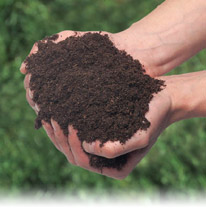 Whether you’re a weekend gardener who barely has time to mow the grass or an avid green thumb dedicated to cultivating the perfect lawn, composting should be an integral part of your garden and lawn care program. Why? Composting is easy and cheap, it’s good for your lawn and garden, and it helps the environment by reducing waste.
Whether you’re a weekend gardener who barely has time to mow the grass or an avid green thumb dedicated to cultivating the perfect lawn, composting should be an integral part of your garden and lawn care program. Why? Composting is easy and cheap, it’s good for your lawn and garden, and it helps the environment by reducing waste.
Composting is the natural decomposition of organic material. With a bin or pile, a backyard composter turns waste like grass clippings, leaves and food scraps into a rich soil additive that can be used to make a more beautiful and healthier lawn and garden. Composting can range from almost effortless — just piling organic matter in a corner of your yard — to sophisticated — mixing various ingredients to get the right nutrient-rich results.
Another popular method is vermicomposting. Vermicomposting uses worms to breakdown organic material. This method does not take up a lot of space making it perfect for apartments, classrooms, or homes with small yards. Click here to find out where you can get started!
Below we review some common compost questions. For more detailed information, please visit CompostEverything.net.
What can I compost?
The basic rules for all compost piles are the same, as listed below:
- Collect these items to start your pile:
- Carbon-rich “browns” — dry materials such as wood chips, dried leaves, sawdust, straw
- Nitrogen-rich “greens” — fresh, moist materials such as grass cuttings, fruit and vegetable scraps, coffee grounds, eggshells, spent flowers and plants and soft prunings from the garden.
- Try to keep your amounts somewhat equal, because too much green material can cause an unpleasant odor (treat by mixing in more browns, or by adding granular lime, available at garden stores).
- Don’t add animal products such as meat, bones, fats and dairy products; anything that has been heavily treated with herbicides or pesticides; cardboard; diseased plants; or pieces of eucalyptus, red cedar or black walnut trees.
- A pile or bin should be at least 3 feet in all directions; 3- or 4-foot piles hold moisture better, get hotter and decompose faster. If the pile is bigger around than around 4 feet, the edges won’t get hot; similarly, piles that are too small don’t heat up enough.
- Place approximately equal amounts of browns and greens in 6- to 12-inch layers in a heap or bin. You can also add barnyard manure, bone meal or other additives available from your home and garden store. Make sure to cover food scraps with other composting materials.
- Watering Compost
- Soak well with water.
- Compost should be kept as moist as a wrung-out sponge.
- Too little moisture can keep the pile from properly heating up and decomposing; too much moisture can cause a rotten odor. Fix this by adding materials such as leaves or shredded newspaper.
- Keep adding materials. This doesn’t mean you have to run to the composter every time you peel a potato. Many people keep their kitchen wastes under the sink in a large plastic container with a resealable lid and a handle. When the container is full, empty it into the compost pile. If you have yard waste, find a suitable area to keep the materials until you can add them to the compost.
- For quicker composting (2-3 months) Chop materials into smaller pieces and moisten. Alternate 3-inch to 6-inch layers of greens and browns. Mix the pile often by turning and stirring. Soak the pile once a week.
- For slower composting (from 3-6 months up to a year) Just keep adding materials to the pile or bin and sprinkle it regularly with water.
- Compost is ready when it is dark and crumbly and has little odor.
How does composting work?
Composting is nature’s way of recycling, and it works by breaking down organic waste like grass clippings, leaves and kitchen waste into smaller and smaller compounds until it becomes soil again. Composting is the easiest way to put nutrients back into your yard and gardens, without fertilizers! By combining nitrogen, carbon and oxygen, organic materials break down into nutrient-rich soil. The following drawing illustrates how composting works:
How do I use compost?
Adding compost to soils aids in erosion control, promotes soil fertility, and stimulates healthy root development in plants. Here are some ideas on how to use your compost:
- Dig it into new planting areas.
- Work into soil on existing flower or vegetable gardens once or twice a year.
- Spread around shrubs, flowers and trees as mulch. Use as a potting mix for indoor and outdoor plants.
- Apply in a wide ring around trees below the drip line.

What type of compost bin should I use?
Although compost can be made in open piles, you’ll get better, faster and neater results with a bin. There are many types of composting bins available through mail order or at your local home and garden stores, or you can make a bin cheaply and easily yourself. Click here to find a local compost bin supplier near you!
Factors to consider when determining which bin will work best for you include cost, convenience, portability, effectiveness and appearance. Here are some design ideas:
- a wire mesh bin with a hinged front panel
- a three-sided cement block bin with an open front so you can turn the pile and remove the finished compost easily
- a circular unit made from chicken wire or fencing that can be opened up to collect the finished compost
- a wooden pallet or 2-by-4 box with a lid and spaces for ventilation
- a metal barrel or garbage can with holes punched in the side and the bottom removed
- for more advanced enthusiasts, a unit with several compartments can be used to manage compost at different stages — raw materials, active piles and finished product.
Whatever type of bin you buy or make, put it in a level, well-drained, accessible area.
Need more information? The following resources will be able to answer your compost questions!
- OSU Extension Master Gardeners: 918-746-3701
- Tulsa Garden Center: 918-746-5125
- The Metropolitan Environmental Trust: 918-584-0584

